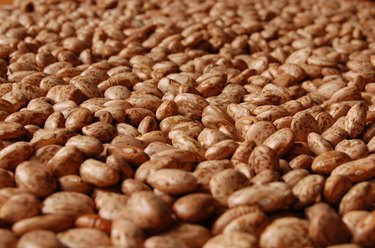
The family of plants known as legumes is one of the most populous plants, and commonly used as food by humans. Legumes are high in protein and are also excellent sources of dietary fiber. Examples of legumes include beans, peas, lentils, peanuts and soybeans. The many varieties of legumes share characteristics that unite them as a group.
Flowers and Fruits
Video of the Day
Legumes feature flower clusters, or inflorescences, which are often very bright and thus used in identification. The pods that legumes produce contain seeds, and they can fracture at two different sites, making it likely they will break apart during the harvesting process.
Video of the Day
Leaves
Legume leafs display one of several different arrangements, including trifoliate (three leaves connected to one central stem,) alternating leaves, pinnate (the central leaflet has a longer stem,) and palmate (leaflets have the same length.) Legumes may also feature what is commonly known as a “watermark,” which is a white marking on the leaf that generally appears as a crescent or a “V” shape. These watermarks can be very useful for scientific identification.
Stipules
Stipules are the leaf structures where the leaf itself attaches to the stem of the plant. Legumes have distinctive stipules that aid in identification. For example, the birdsfoot trefoil, a perennial legume that is often used to produce forage for livestock, has very large stipules that give it the appearance of several leaflets Other varieties of legume have stipules with papery or veiny marks.
Seeds
The seeds that legumes produce tend to be very round and opaque. They are frequently very hard, so the plant can sometimes be difficult to germinate because the seedling cannot break through the seed case. Some common varieties of legumes have very small seeds, so farmers must be very careful during the planting process to ensure to maximize the number of seeds that will germinate. Humans eat several types of legume seeds, including beans, peas, lentils and peanuts.
Stems
The stems of legumes exhibit different lengths, sizes, woodiness and number of branches. Two types of stems that occur in forage legumes (such as alfalfa,) are stolongs, which are horizontal stems that occur above the ground, and rhizomes, which are horizontal stems that are underground.